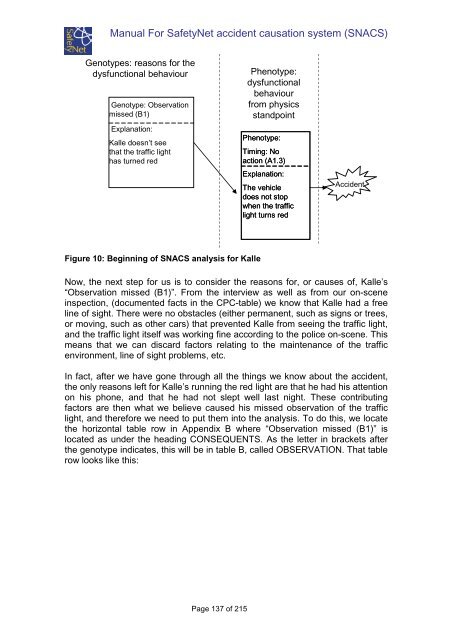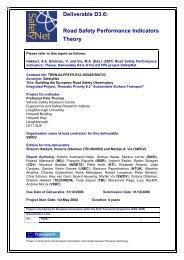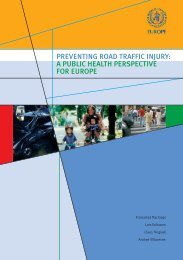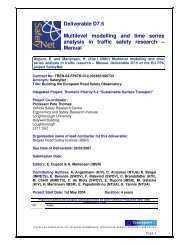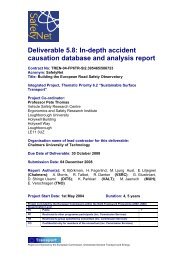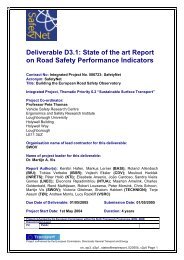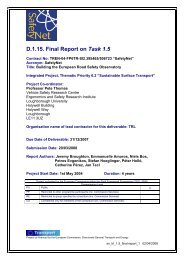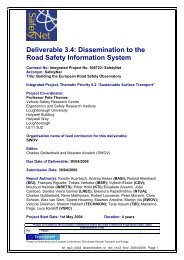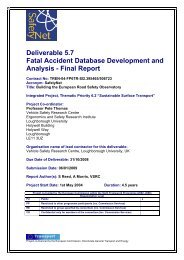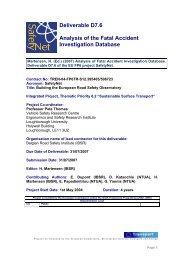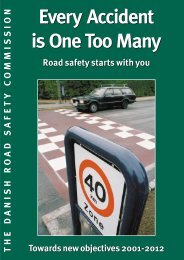Glossary of Data Variables for Fatal and accident causation ... - ERSO
Glossary of Data Variables for Fatal and accident causation ... - ERSO
Glossary of Data Variables for Fatal and accident causation ... - ERSO
Create successful ePaper yourself
Turn your PDF publications into a flip-book with our unique Google optimized e-Paper software.
Manual For SafetyNet <strong>accident</strong> <strong>causation</strong> system (SNACS)<br />
Genotypes: reasons <strong>for</strong> the<br />
dysfunctional behaviour<br />
Genotype: Observation<br />
missed (B1)<br />
Explanation:<br />
Kalle doesn’t see<br />
that the traffic light<br />
has turned red<br />
Phenotype:<br />
dysfunctional<br />
behaviour<br />
from physics<br />
st<strong>and</strong>point<br />
Phenotype:<br />
Timing: No<br />
action (A1.3)<br />
Explanation:<br />
The vehicle<br />
does not stop<br />
when the traffic<br />
light turns red<br />
Accident<br />
Figure 10: Beginning <strong>of</strong> SNACS analysis <strong>for</strong> Kalle<br />
Now, the next step <strong>for</strong> us is to consider the reasons <strong>for</strong>, or causes <strong>of</strong>, Kalle’s<br />
“Observation missed (B1)”. From the interview as well as from our on-scene<br />
inspection, (documented facts in the CPC-table) we know that Kalle had a free<br />
line <strong>of</strong> sight. There were no obstacles (either permanent, such as signs or trees,<br />
or moving, such as other cars) that prevented Kalle from seeing the traffic light,<br />
<strong>and</strong> the traffic light itself was working fine according to the police on-scene. This<br />
means that we can discard factors relating to the maintenance <strong>of</strong> the traffic<br />
environment, line <strong>of</strong> sight problems, etc.<br />
In fact, after we have gone through all the things we know about the <strong>accident</strong>,<br />
the only reasons left <strong>for</strong> Kalle’s running the red light are that he had his attention<br />
on his phone, <strong>and</strong> that he had not slept well last night. These contributing<br />
factors are then what we believe caused his missed observation <strong>of</strong> the traffic<br />
light, <strong>and</strong> there<strong>for</strong>e we need to put them into the analysis. To do this, we locate<br />
the horizontal table row in Appendix B where “Observation missed (B1)” is<br />
located as under the heading CONSEQUENTS. As the letter in brackets after<br />
the genotype indicates, this will be in table B, called OBSERVATION. That table<br />
row looks like this:<br />
Page 137 <strong>of</strong> 215


